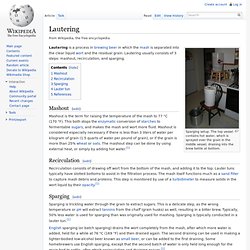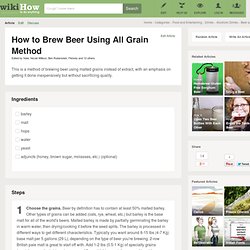

CRAP_AMM.pdf. NORMA OFICIAL MEXICANA NOM-142-SSA1-1995. How Many Kegs Per CO2 Cylinder. Beer Color SRM to RGB Conversion. Beer Color SRM to RGB Conversion. Lautering. Sparging setup.

The top vessel contains hot water, which is sprayed over the grain in the middle vessel, draining into the brew kettle at bottom. Lautering is a process in brewing beer in which the mash is separated into the clear liquid wort and the residual grain. Lautering usually consists of 3 steps: mashout, recirculation, and sparging. Mashout[edit] Mashout is the term for raising the temperature of the mash to 77 °C (170 °F). Recirculation[edit] Sparging[edit] Sparging is trickling water through the grain to extract sugars. English sparging (or batch sparging) drains the wort completely from the mash, after which more water is added, held for a while at 76 °C (169 °F) and then drained again. How To Taste Beer. Digital Designs for Physical Objects. View More DRINK-DICE by Qxo May 5, 2013 Collection Cover Remove Maker-Bottle-Moustaches by wulfdesign Oct 29, 2010 Bottle-Moustaches by overflo Oct 29, 2010 Another 2 beer holder carrier by DaniSaez Feb 27, 2014 Antoher 4 beer carrier/holder by DaniSaez Feb 27, 2014 Winemaking siphon parts by Lenbok Dec 23, 2012 Bottle Drying Stand (Parametric) by doommeister Oct 6, 2011.

The Raspberry Pi Brewing ControllerBrewPi.com. Pete_landscape.jpg (1080×689) Brew Beer Using All Grain Method. Edit Article Edited by Nate, Nicole Willson, Ben Rubenstein, Flickety and 12 others This is a method of brewing beer using malted grains instead of extract, with an emphasis on getting it done inexpensively but without sacrificing quality.

Ad Steps 1Choose the grains. Tips An outdoor burner with a converted keg for boiling is a good investment. Warnings Don't be a hero and try to drink spoiled batches of beer. All-Grain Brewing: How To Build a Mash Tun. BrewMasters. Insumos e Ingredientes para Elaborar Cerveza. Una de las preguntas e incognitas más frecuentes del cervecero artesanal o casero es cómo calcular con precisión el contenido de alcohol de la cerveza.

Descifremos el misterio de Cómo Medir el Alcohol en nuestra Cerveza. Y es que ahora en estos tiempos, en que “todo” lo podemos encontrar en Internet, también podemos confundirnos o mal-informarnos más: Que si multiplícale por 105, que sí divídele por un factor, que súmale, pero réstale, es algo de lo que comúnmente escucho. Y cuando alguien sale con una fórmula heroica, rara vez sabe si es correcta o de donde salió. Así que resolvamos esta cuestión básica de cómo medir el alcohol en la recién cerveza que hemos elaborado.
El método más común para determinar el contenido de alcohol de la cerveza, es comparar la densidad del líquido antes y después de fermentar. La Densidad de un líquido es la relación entre su masa y su volumen. donde P es la densidad, m la masa, y V el volumen. How Beer Works" Brew Science - Homebrewing Blog. How to Brew All Grain Beer - Part 4. Small Scale Brewing. Sometimes scaling down your brewing efforts can scale up your enthusiasm. Homebrew can be made in smaller batches than 5 gallons (19 L) and we give you the how, why and when to brew efficiently at a reduced scale. There is a tendency for some homebrewers to go big. Their enthusiasm for the hobby drives these brewers to build bigger systems that more resemble craft breweries than the kitchen-based efforts that are at their roots.
At the same time, other homebrewers are moving in the opposite direction, brewing in smaller batches. Reasons for brewing smaller batches include meeting the demands of limited space, trying out new recipes (especially those with expensive ingredients), conducting experiments or just to brew more often but to produce less beer to store and “dispose” of.Small Volume = Big FunBrett Niland, from Tulsa, Oklahoma, latched onto the small batch concept with a fanatical fervor. Tipos de Maltas y Usos. Beer measurement. A hydrometer floating in a test jar of wort.

The specific gravity reading is approximately 1.050. When drinking beer, there are many factors to consider. Principle among them are bitterness, the variety of flavours present in the beverage, along with their intensity, alcohol content, and colour. Standards for those characteristics allow a more uniform determination to be made on the overall quality of any beer. Colour[edit] The Standard Reference Method or SRM [2] is a system modern brewers use to measure colour intensity, roughly darkness (but see Tristimulus Colour below), of a beer or wort. Version 2.3.2 - The Browser-Based Homebrew Logging Solution. Mrmalty.com.
Beer measurement. Advanced Chemistry of Beer and Brewing » ACS Webinars ® Advanced Chemistry of Beer and Brewing ACS Webinars: Joy of Science Channel“Advanced Chemistry of Beer and Brewing” A short presentation followed by Q&A with speaker Charles Bamforth, Anheuser-Busch Endowed Professor of Malting & Brewing Sciences at UC Davis.

Do you like your beer malty? Hoppy? Smooth? Light? View flyer as PDF Download Charlie’s Presentation Slides! Access to archived ACS Webinars is a benefit to ACS members. What You Will Learn. How Beer Works"